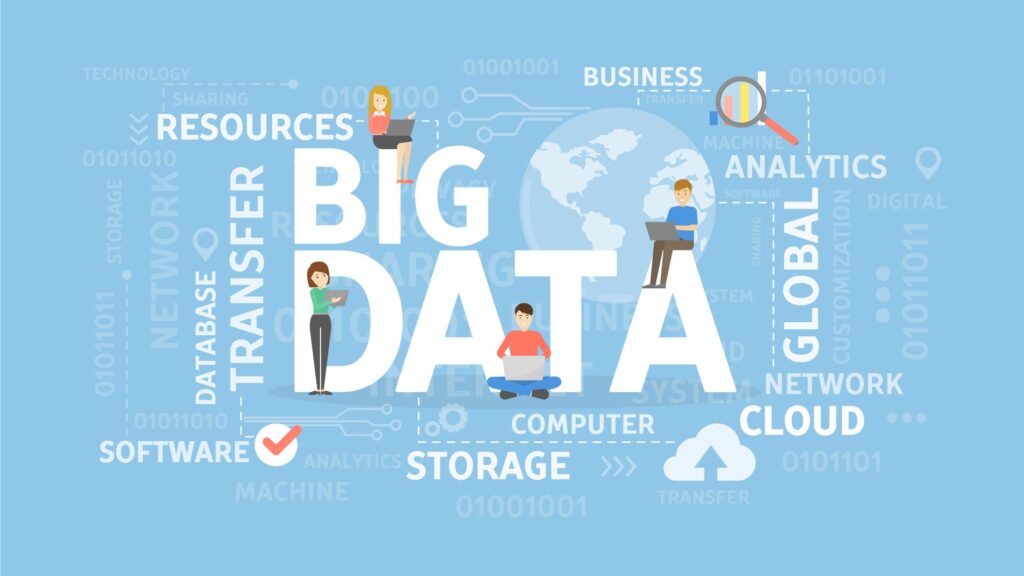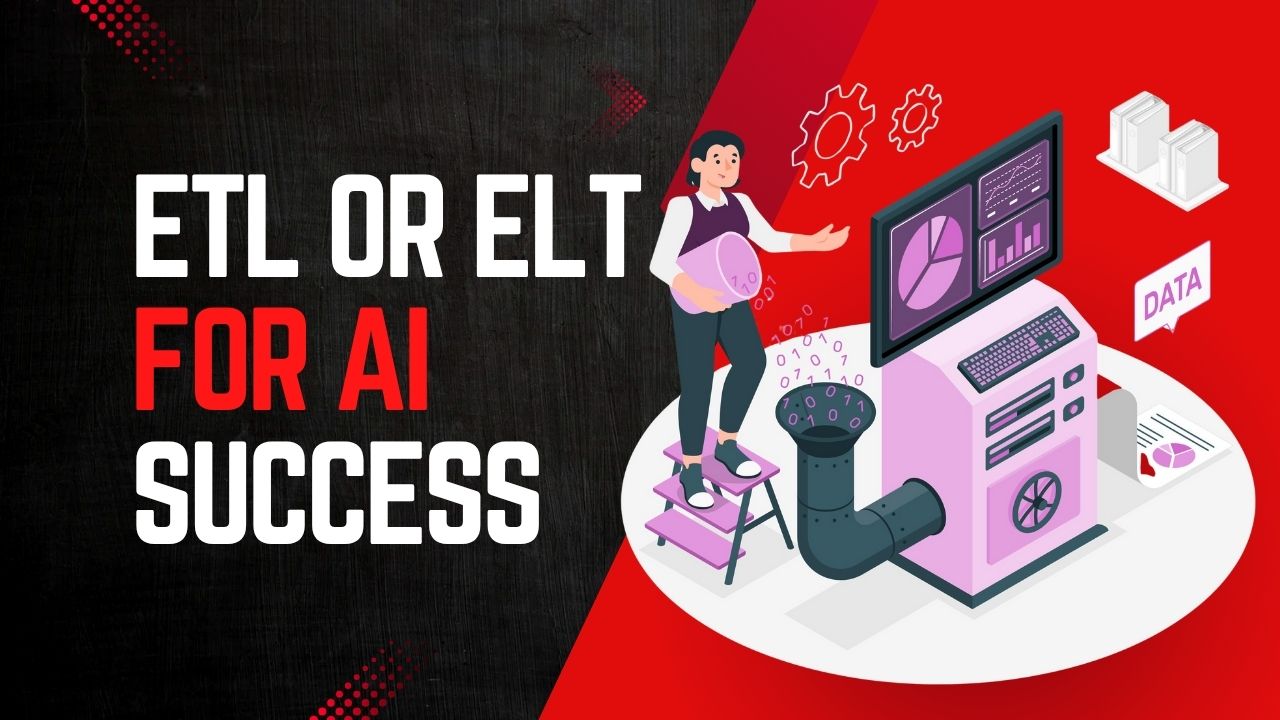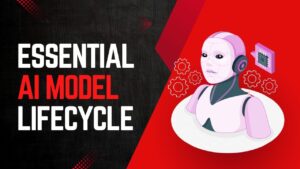Key Points
- ETL (Extract, Transform, Load) and ELT (Extract, Load, Transform) are two primary methods for data integration, each with distinct approaches to preparing data for AI and analytics.
- ETL transforms data before loading it into a target system, making it suitable for structured data and compliance-sensitive scenarios.
- ELT loads raw data first and transforms it within the target system, leveraging cloud scalability for large, diverse datasets.
- The choice between ETL or ELT depends on factors like data volume, transformation complexity, and compliance needs, with no universally superior method.
- Both approaches are critical for delivering clean, usable data to power AI models and analytics dashboards, but their application varies based on infrastructure and use case.
On This Page
Table of Contents
Introduction to Data Integration
In today’s data-driven world, organizations rely on high-quality, accessible data to fuel artificial intelligence (AI) and analytics. Data integration is the process of combining data from disparate sources—databases, applications, cloud platforms, or files—into a unified, usable format. Without proper integration, data remains fragmented, like puzzle pieces scattered across different tables, making it impossible to see the full picture.
ETL (Extract, Transform, Load) and ELT (Extract, Load, Transform) are two cornerstone methods for data integration. They serve the same goal—delivering clean, trusted data—but differ in their approach, much like two chefs preparing the same dish with different techniques. This guide explores these methods, their differences, use cases, and how they power AI and analytics pipelines, using analogies, examples, and technical insights to make the concepts clear and engaging.
Understanding ETL
ETL is a time-tested data integration process that has been used for decades, particularly in traditional data warehousing environments. It involves three steps:
- Extract: Data is gathered from various sources, such as relational databases (e.g., MySQL), cloud applications (e.g., Salesforce), or flat files (e.g., CSV files).
- Transform: The extracted data is processed to meet the needs of the target system. This can include cleaning (removing duplicates or errors), enriching (adding calculated fields), or masking sensitive information like personally identifiable information (PII).
- Load: The transformed data is loaded into a target system, such as a data warehouse (e.g., Amazon Redshift) or data lakehouse, where it’s ready for analysis.
ETL is like a water treatment plant: raw water (data) is extracted from rivers (sources), purified at a central facility (transformed), and then piped to homes (loaded). This ensures only clean water reaches the end user, just as ETL ensures only processed data reaches the target system.
Advantages of ETL
- Data Quality: Transformations ensure data is clean and consistent before storage.
- Compliance: Sensitive data, like PII, can be removed or masked before loading, reducing compliance risks (e.g., GDPR, HIPAA).
- Cost Efficiency: By transforming data before loading, ETL reduces the volume of data stored, potentially lowering storage costs.
- Complex Transformations: ETL is well-suited for intricate transformations, such as joining multiple datasets or applying complex business logic.
Use Cases for ETL
- Data Warehousing: Populating data warehouses with structured data for business intelligence and reporting.
- Financial Systems: Consolidating transaction data while ensuring compliance with regulations.
- Marketing Analytics: Integrating data from marketing tools (e.g., Google Analytics, HubSpot) for campaign analysis.
Example of ETL
Consider a bank that needs to consolidate transaction data from multiple branches to generate financial reports. The data includes customer IDs, transaction amounts, and dates, but it’s stored in different formats across systems, and some records contain sensitive PII.
Using ETL:
- Extract: Pull data from branch databases and online banking systems.
- Transform: Standardize date formats, remove PII (e.g., customer names), and calculate total transactions per account.
- Load: Store the processed data in a central data warehouse for reporting.
This ensures compliance and delivers clean data for analytics, such as identifying spending trends or detecting fraud.
Understanding ELT
ELT is a modern data integration approach that leverages the power of cloud-based data warehouses and data lakes. It reverses the transformation and loading steps:
- Extract: Data is pulled from sources, similar to ETL.
- Load: Raw, unprocessed data is loaded directly into a target system, such as a data lake or cloud data warehouse (e.g., Snowflake, Google BigQuery).
- Transform: Transformations are performed within the target system using its scalable computing resources, often via SQL or tools like dbt.
ELT is like piping raw water into a reservoir and treating it there using built-in filtration systems. This approach takes advantage of modern cloud platforms’ ability to handle large datasets and perform transformations efficiently.
Advantages of ELT
- Scalability: ELT leverages cloud platforms’ elastic compute resources, making it ideal for large datasets.
- Flexibility: Raw data is stored first, allowing analysts to transform it as needed for different use cases.
- Speed: Loading raw data is faster, enabling near-real-time analytics.
- Support for Unstructured Data: ELT handles diverse data types, such as images or logs, common in AI applications.
Use Cases for ELT
- Big Data Analytics: Processing large volumes of structured and unstructured data for insights.
- Real-time Processing: Loading data quickly for immediate analysis, such as monitoring user activity.
- Data Exploration: Enabling data scientists to experiment with raw data for AI model development or ad-hoc analysis.
Example of ELT
A social media company collects vast amounts of user interaction data—posts, likes, and comments—to analyze engagement and improve its platform. The data is unstructured and voluminous, making **ELT彼此
- Extract: Pull data from APIs and internal databases.
- Load: Store raw data in a cloud data lake (e.g., AWS S3).
- Transform: Use SQL queries in a cloud data warehouse (e.g., Snowflake) to perform sentiment analysis, categorize posts, or calculate engagement metrics.
This approach allows the company to store all data and transform it flexibly for various analytics tasks, such as predicting user trends or optimizing ad targeting.
Comparing ETL and ELT
While both ETL and ELT achieve data integration, their differences impact their suitability for specific scenarios. Here’s a detailed comparison:
| Aspect | ETL | ELT |
|---|---|---|
| Process Order | Extract → Transform → Load | Extract → Load → Transform |
| Transformation Location | Outside the target system (e.g., ETL server) | Inside the target system (e.g., data warehouse) |
| Data Staging | Requires a staging area for transformation | No staging area; transformations done in-place |
| Compliance | Can remove sensitive data before loading | Loads all data, increasing compliance risks |
| Cost | Reduces storage costs by loading only transformed data | May increase storage costs due to raw data |
| Scalability | Limited by ETL server capacity | Leverages cloud scalability |
| Flexibility | Transformations are predefined | Transformations can be adjusted on-the-fly |
| Speed | Slower for large datasets due to pre-loading transformation | Faster loading, with transformations as needed |
| Data Types | Best for structured data | Handles structured and unstructured data |
When to Use ETL
- Complex Transformations: When data requires extensive processing, such as joining multiple sources or applying business rules.
- Compliance Needs: When regulations (e.g., GDPR, HIPAA) require sensitive data to be masked before storage.
- Legacy Systems: When working with on-premises infrastructure or structured data environments.
When to Use ELT
- Large Datasets: When handling massive volumes of data, especially unstructured data like logs or media.
- Cloud Environments: When using scalable cloud data platforms like Snowflake or BigQuery.
- Flexible Analysis: When analysts need to explore raw data and perform transformations on-demand.
TETL: A Hybrid Approach
Some organizations use a hybrid approach called TETL (Transform, Extract, Transform, Load). This involves an initial transformation at the source before extraction, followed by additional transformations after loading. For example, a lightweight transformation might filter out irrelevant data at the source to reduce transfer volume, with further processing in the target system. TETL is less common but useful in specialized cases, such as hybrid cloud-on-premises environments where compliance and efficiency are both priorities.
Real-world Example: Water Filtration System
To make ETL and ELT easier to understand, consider a water filtration system. In ETL, water is extracted from rivers, treated at a central purification plant to remove impurities, and then piped to homes for use. This ensures only clean water reaches the destination, but the process can be time-consuming. In ELT, raw water is piped directly to a reservoir, where built-in filtration systems treat it as needed. This is faster and more flexible, allowing different treatments for different uses, but requires robust reservoir systems to handle raw water safely.
Both methods deliver clean water (data), but the choice depends on the infrastructure (e.g., cloud vs. on-premises) and needs (e.g., immediate use vs. flexible analysis).
Technical Considerations
Choosing between ETL and ELT involves weighing several factors:
- Performance: ETL can be more efficient for complex transformations using dedicated processing engines, while ELT relies on the target system’s compute, which may be optimized for querying rather than heavy transformations.
- Cost: ETL reduces storage costs by loading only transformed data, while ELT may increase storage needs but leverages pay-as-you-go cloud compute.
- Compliance: ETL allows sensitive data to be filtered before loading, reducing risks. ELT requires strong governance to manage raw data in the target system.
- Scalability: ELT excels in cloud environments with elastic compute resources, while ETL may face bottlenecks with large datasets unless the processing engine is highly robust.
Implementing ETL and ELT
Implementing ETL or ELT requires selecting tools that align with your data architecture. Many modern tools support both approaches, offering flexibility.
Popular Tools
- ETL Tools:
- Informatica PowerCenter: Robust for enterprise-grade ETL with extensive transformation capabilities.
- Talend: Open-source and commercial options for ETL and ELT.
- Microsoft SSIS: Ideal for Microsoft-centric environments.
- Apache NiFi: Flexible for real-time data flows.
- ELT Tools:
- dbt: Popular for SQL-based transformations in cloud data warehouses.
- Fivetran: Automated ELT with pre-built connectors.
- Matillion: Cloud-native, supporting both ETL and ELT.
- AWS Glue: Serverless ETL and ELT for AWS ecosystems.
Example Implementation
For ETL, a Python script using pandas might extract data from a CSV file, clean and aggregate it, then load it into a database. For ELT, raw data might be loaded into a cloud data warehouse like Snowflake, where SQL queries transform it into analytical views. Here’s a simplified example of an ELT transformation using SQL:
-- Create a transformed table from raw data
CREATE TABLE analytics.user_engagement AS
SELECT user_id, COUNT(*) as interaction_count, MAX(timestamp) as last_interaction
FROM raw_data.user_interactions
GROUP BY user_id;This query aggregates user interactions in a cloud data warehouse, showcasing ELT’s in-place transformation.
Conclusion
ETL and ELT are powerful data integration strategies that enable organizations to harness data for AI and analytics. ETL is ideal for structured data, compliance-sensitive scenarios, and complex transformations, ensuring data is clean before storage. ELT excels in cloud environments, handling large, diverse datasets with flexible, on-demand transformations. The choice depends on your infrastructure, data volume, and use case—whether you need pre-processed data for compliance or raw data for exploratory analysis. By understanding these approaches, you can build robust data pipelines that deliver trusted data to power AI models, business intelligence, and strategic decision-making.

FAQs
What are ETL and ELT, and why do they matter?
ETL and ELT are ways to collect, clean, and prepare data so it can be used for things like analytics (think business reports) or AI (like training models to predict trends). They matter because businesses need clean, organized data to make smart decisions, like figuring out what customers want or spotting fraud. Without ETL or ELT, your data is like a messy kitchen—you can’t cook a good meal (or get useful insights) if everything’s scattered.
ETL: Pulls data from sources, cleans it up, then stores it in a system like a data warehouse.
ELT: Pulls data, stores it as-is, then cleans it up inside the storage system.
How is ETL different from ELT?
The big difference is when the data gets cleaned:
In ETL, you clean and organize data before storing it. It’s like washing and chopping vegetables before putting them in the fridge.
In ELT, you store the raw data first and clean it later using the storage system’s tools. It’s like tossing all your groceries in the fridge and prepping them when you’re ready to cook.
ETL is great for making sure data is perfect before it’s stored, while ELT is faster and more flexible, especially with big datasets in the cloud.
When should I use ETL?
Use ETL when:
You need super clean data before storing it, like when dealing with sensitive info (e.g., customer names or credit card numbers).
You’re working with older systems that aren’t great at processing data themselves.
You want to save on storage costs by only keeping processed data.
Your data needs a lot of complex changes, like combining multiple sources or fixing errors.
For example, a bank might use ETL to remove personal details from transaction data before storing it to meet privacy laws.
When should I use ELT?
Go for ELT when:
You’re using a powerful cloud system (like Snowflake or Google BigQuery) that can handle data processing itself.
You’re dealing with tons of data, like social media posts or website clicks, and need to store it quickly.
You want flexibility to analyze data in different ways later, like for AI or ad-hoc reports.
Speed is key, and you don’t mind cleaning data after it’s stored.
For instance, a streaming service might use ELT to store all user activity (raw data) and later analyze it to recommend shows.
Which is better for AI and analytics?
Neither is “better”—it depends on your needs:
ETL is great for analytics when you need structured, clean data for reports, like sales dashboards. It’s also good for AI when models need consistent, pre-processed data (e.g., fraud detection).
ELT shines for AI and big data analytics because it stores raw data, letting you experiment with different transformations. For example, AI models training on diverse data (like images or text) benefit from ELT’s flexibility.
Think of ETL as preparing a set meal and ELT as a buffet—you pick what to prep when you’re ready.
How do ETL and ELT affect costs?
ETL: Can save money on storage because you only store cleaned data. But, it might need a powerful server for transformations, which can be pricey.
ELT: Might cost more for storage since you’re keeping raw data, but it uses cloud systems’ built-in power, which can be cheaper for big transformations.
For example, ETL is like buying pre-chopped veggies (less fridge space but more prep cost), while ELT is like buying whole veggies (more fridge space but cheaper prep with your own tools).
Can ETL or ELT help with sensitive data?
Yes, but they handle it differently:
ETL: Cleans sensitive data (like names or addresses) before storing it, which is great for meeting privacy rules (e.g., GDPR). It’s like shredding personal info before filing papers.
ELT: Stores raw data, including sensitive stuff, so you need strong security and rules to clean it later. It’s like locking sensitive papers in a safe and organizing them when needed.
If privacy is a big concern, ETL might be safer because it processes sensitive data upfront.
Do I need special tools for ETL or ELT?
Yes, but many tools work for both:
ETL Tools: Informatica, Talend, or Apache NiFi are great for complex transformations before loading.
ELT Tools: dbt, Fivetran, or Matillion work well with cloud systems for in-place transformations.
Some tools, like AWS Glue, support both ETL and ELT, giving you flexibility.
It’s like choosing between a fancy food processor (ETL) or a multi-tool blender in your kitchen (ELT).
What’s this TETL I’ve heard about?
TETL (Transform, Extract, Transform, Load) is a hybrid. You do a quick cleanup at the source (like filtering out junk data), extract it, then do more cleaning before or after storing. It’s like rinsing veggies at the store, then chopping them at home. TETL is less common but useful when you want to lighten the load on your system while keeping some ELT flexibility.




